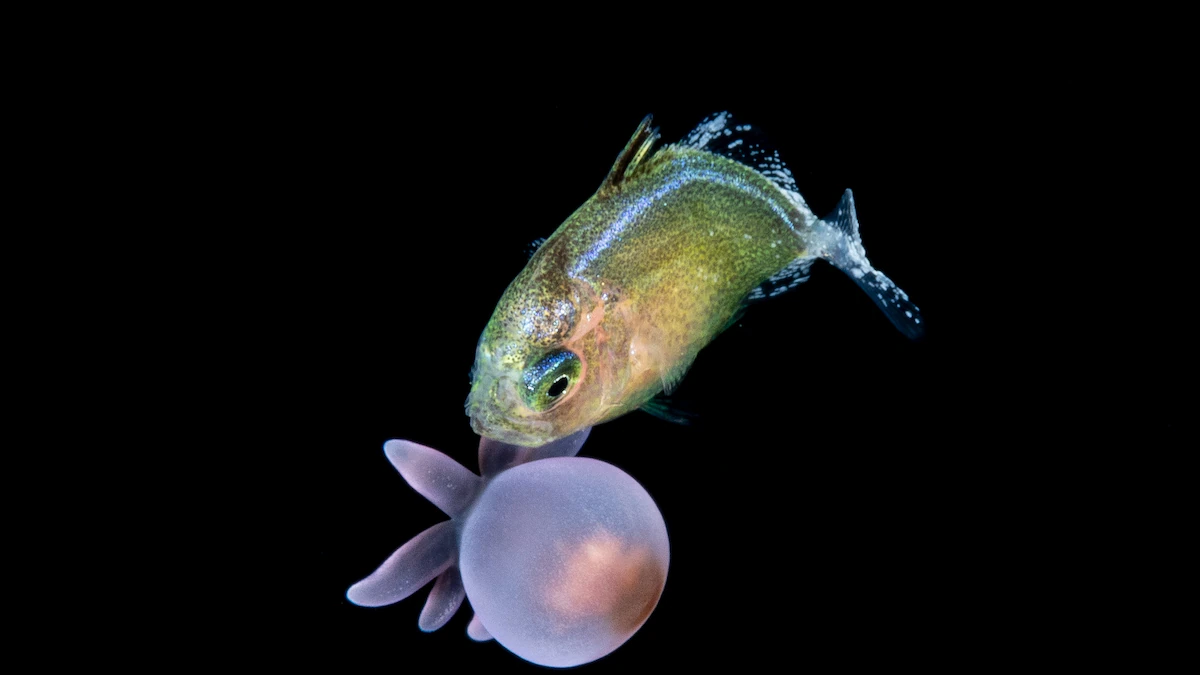
Against the blackness of water at night, the pomfret looked like it had blown a big bubble from gum. Instead, the fish had the larva of an anemone sticking out of its mouth.
This was just one example of fish interacting with anemones in surprising ways that scientists documented in a new study in the Journal of Fish Biology. Photos taken by divers at night — during so-called “blackwater diving” — show young fish hanging out with and even holding potentially dangerous anemones, possibly using them as shields.
Researchers say this behavior may help the tiny fish avoid becoming a predator’s dinner. In the open ocean, “you have to find ways to protect yourself,” says Gabriel Afonso, an ichthyologist at the Virginia Institute of Marine Sciences in Gloucester Point, and lead author of the study. He says these fish getting chummy with anemones could be a new case of fish hiding behind invertebrates.
A primordial sea
Scientists got the idea to look for this behavior in photos from divers after Jeff Milisen, a marine biologist and independent researcher based in Kona, Hawaii, spotted something unusual.
In 2015 while blackwater diving near Kona, Milisen saw a fish holding what appeared to be a ball with its pelvic fins. The identities of the creatures were unknown at the time. It’s not uncommon to see fish hanging out with invertebrates, he says, but this seemed like a strange interaction. Milisen passed his photos along to Dave Johnson, one of the study authors who passed away prior to the new report’s publication.
LIMITED TIME OFFER
While scientists have traditionally studied fish that have been scooped up and brought on land for further investigation, “there’s an enormous amount of information that can be gleaned just by putting your face in the water and having a look around,” says Milisen, who was not a co-author of the new report.
For the new study, Johnson, Afonso and their colleagues collected images from other blackwater divers taken between October 2018 and August 2023.
Blackwater divers plunge into the ocean in the dark of night and photograph what they illuminate with flashlights or other lights. Many of the animals featured in blackwater divers’ photos are drawn to the light and they are often small—less than an inch long. “It’s what I think of as almost a primordial sea,” Milisen says.
Afonso’s team examined photos that divers snapped at depths of 26 to 50 feet during scuba dives off the coasts of Florida and Tahiti. In one, they saw a filefish holding a yellow larval anemone in its mouth. In another, a juvenile jack swam close to young anemones, while a different scene showed a young driftfish doing the same thing. And a pomfret seemed to be riding another creature, held between the fish’s fins. This blobby animal was an unidentified anthozoan, a member of the group that includes anemones.
Why do they do it?
In a featureless environment with nowhere to hide, the fish could be defending themselves with anemones, the researchers suggest. Adult anemones have stinging cells, and at least some larval anemones are toxic. In the case of the jack, the diver noticed that the fish seemed to try to keep the anemone between itself and the diver. “The fish hides behind the anemone using it as a barrier,” Afonso says. “That’s our interpretation.”
Researchers have long known that fishes hang around other stinging creatures, especially jellyfish. Scientists have made repeated observations of fish swimming near them, schooling around them and even sheltering in their tentacles, says Jeff Leis, a fish biologist at the University of Tasmania in Hobart, Australia who wasn’t part of the study. In February 2025, the study authors shared photos of fish with jellyfish hanging out of their mouths in the Journal of the Ocean Science Foundation. And some fish even appear to mimic jellyfish. But it’s not clear yet how common this sort of interaction between fish and anemones in the open ocean is, Leis says, given that only a few species were reported here.
The study authors also suggest that the tiny fish might help the anemones spread. But Milisen is skeptical because larval fish straddle the line between free-floating creatures and ones that propel themselves,. “Either way, the larval fish don’t swim all that well or all that far,” he says. Even if the fish do help move anemones, it’s possible that hitching a ride isn’t beneficial, for instance, if it moves anemones away from an ideal spawning location.
The curious observations raise many questions. Afonso’s team wonders how the fish can hold anemones without getting hurt, and how long relationships between fish and anemones last. Are fish holding these organisms for minutes, days or weeks? And Leis wonders: How do the fish eat if they are holding another animal in their mouths?
One takeaway from this research is that photos from blackwater divers could provide new clues about the biology of larval and juvenile fishes. Studying these open ocean-dwelling youngsters can be challenging, Afonso says, as their appearance can change drastically as they become adults.
To humans, the ocean can look like a simple layer of blue, Afonso says. Without diving, researchers will miss a lot of the interactions like these below the surface. “There is so much complexity down there.”